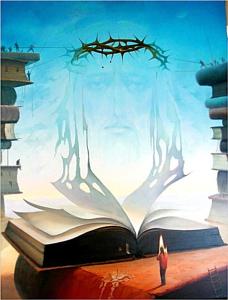When I read a passage in the gospels, I like to read backward and forward a chapter or two, taking in the larger narrative the passage is a part of. This reading shines a searchlight on an area, rendering a high-resolution view. I found the practice helpful with Mark 13:1-8 [lectionary the week this essay was originally published], which portrays Jesus predicting the fall of the Temple—a passage frequently poorly interpreted. So, what leads up to it?
First, on the day we traditionally call Palm Sunday, Jesus enters the festival city triumphally, to great fanfare; then he heads over and storms the Temple, confronting an oppressive system of trade; he knocks over tables and launches a scene. In this context, we find crisis building in Mark, words about destruction to come; officials try to trip Jesus up. They want to trap him, to get him to say the wrong thing as his confrontation with the domination system builds.

Then, we get to today’s passage about the Temple crumbling—this central symbol in Jesus’ day of economic and social inequality. As Jesus says, things will fall apart, but it’s not the end. Afterward, Jesus warns his followers that hardship, including strife in relationships, will come, but they can trust the Spirit’s guidance. As even more is said about coming crises, Jesus is anointed for his death.
That is the broader picture; and it is fascinating! We don’t randomly have a passage commonly interpreted as a commentary on the end of the world. It is one short text in a long story about Jesus’ confrontation with the dominant powers, about Jesus’ worldview-altering movement, and his challenge to the oppressors of his day.
Now before going further, one critical point: The people cast as enemies in the story—namely Jewish leaders, are the people in conflict with Jesus’ followers decades later when Mark was written, when the Jesus movement was making a interfamilial break from the synagogue. Crucifixion was a Roman execution method, and it was the Romans who killed Jesus as a political dissident, supported by the elite class in Palestine who acted as their clients and pawns. Jewish leaders did not plot Jesus’ death, and it’s a repugnant tragedy of history that the story cast Jewish leaders in this role. We must point out and resist this characterization—and the anti-Semitism it gave birth to—at every turn.
So, pivoting to the broader context of the passage, we ask, What was Mark building toward with all of this conflict? Again, the story builds toward Jesus’ showdown with the governmental-market powers of his day. Two things are especially important to acknowledge: first, consensus holds that Mark was finalized after the 70 CE war between Rome and dissidents in Palestine in which the Temple was destroyed. And second, at the time of the incipient Jesus movement, Jesus’ followers thought he would quickly, imminently return, bringing the end of days on this Earth and the fully realized “kingdom of God.” Of course, we know they were mistaken.
But in the way Mark tells Jesus’ story decades after the events of Jesus’ life, he pulls many things together. Significantly, he chooses to write what he called a “gospel” or “good news” story about Jesus’ life. It was full of crisis and mounting tension as in any great storytelling, but despite the conflict, is offered up as great news. What does this mean for us?
This week I’ve pondered how, with climate change, we are—maybe more than any people group in human history, staring down valid warnings of the planet’s and humanity’s demise. In this way, we are unique. Are we the first group of humans truly needing to grapple with the prospect of the “end of the world,” or at least the end of human presence on Earth?
Significant climate summits recently took place. But after all of these meetings, after all of the decisions made by world leaders, do we feel hopeful they will enact changes to secure our future? Honestly, many of us feel powerless, since small, personal changes do little if governments don’t enact bold change.
In this passage, disciples come to Jesus looking for answers and predictions. Essentially, he tells them to stop. He says, Do not be alarmed when you see certain things, which is much like the phrase repeatedly found in scripture when someone encounters God or an angel. They are told: “Do not be afraid.” But the fact is, the time of the Roman wars in Palestine—when the Temple was destroyed—were horrific times for residents. People had reason to worry, as we have reason to worry about climate change consequences.
Yet we know that in the face of those terrible things, both Jesus’ followers and the Jewish people who pivoted toward synagogue-centered religious structures, literally changed the world that came after them, and in many healing ways. They were faithful to the tiny part of the work placed before them. And that is what we have to do. Each of us must be faithful to the tiny part of the work that is placed before us. And to do it without fear or living like crazy people who feed an unhelpful panic. To do this requires faith. It requires feeding our spirits and being healthy spiritually, mentally, emotionally. Such healthfulness ripples out like a wave and does create change. No doubt about it—the challenges are towering, but we all have our small part of the work of meeting those challenges. In that work, every one of us matters.
So let us be focused, and stay healthy, and keep the faith.

















